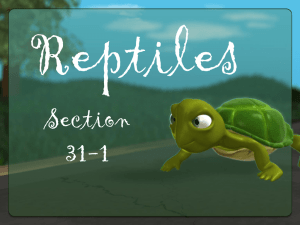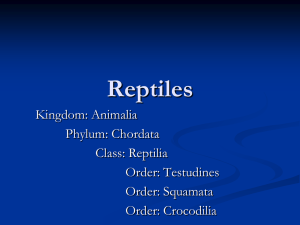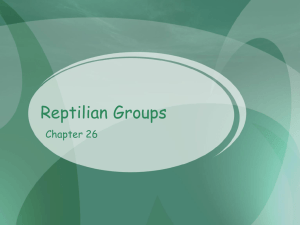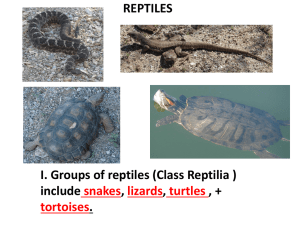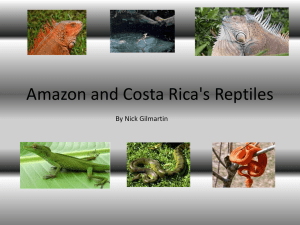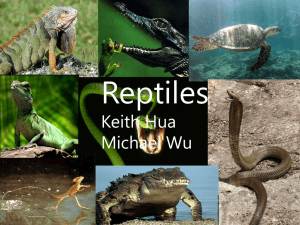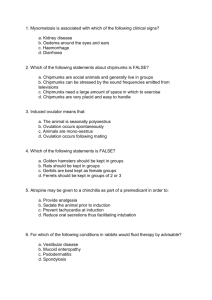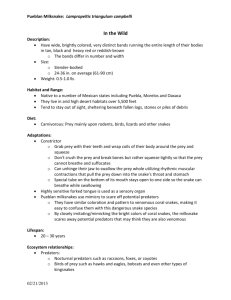Vertebrate Zoology BIOL 322/Reptilia Ch 26 revised from 2011 Book
advertisement
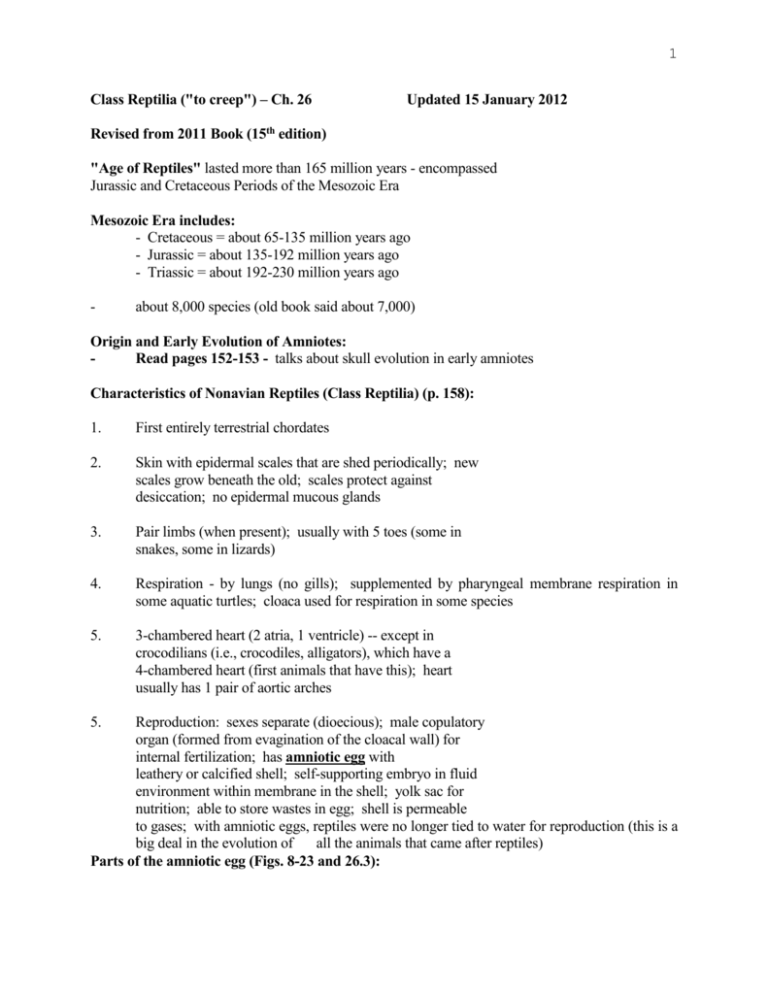
1 Class Reptilia ("to creep") – Ch. 26 Updated 15 January 2012 Revised from 2011 Book (15th edition) "Age of Reptiles" lasted more than 165 million years - encompassed Jurassic and Cretaceous Periods of the Mesozoic Era Mesozoic Era includes: - Cretaceous = about 65-135 million years ago - Jurassic = about 135-192 million years ago - Triassic = about 192-230 million years ago - about 8,000 species (old book said about 7,000) Origin and Early Evolution of Amniotes: Read pages 152-153 - talks about skull evolution in early amniotes Characteristics of Nonavian Reptiles (Class Reptilia) (p. 158): 1. First entirely terrestrial chordates 2. Skin with epidermal scales that are shed periodically; new scales grow beneath the old; scales protect against desiccation; no epidermal mucous glands 3. Pair limbs (when present); usually with 5 toes (some in snakes, some in lizards) 4. Respiration - by lungs (no gills); supplemented by pharyngeal membrane respiration in some aquatic turtles; cloaca used for respiration in some species 5. 3-chambered heart (2 atria, 1 ventricle) -- except in crocodilians (i.e., crocodiles, alligators), which have a 4-chambered heart (first animals that have this); heart usually has 1 pair of aortic arches 5. Reproduction: sexes separate (dioecious); male copulatory organ (formed from evagination of the cloacal wall) for internal fertilization; has amniotic egg with leathery or calcified shell; self-supporting embryo in fluid environment within membrane in the shell; yolk sac for nutrition; able to store wastes in egg; shell is permeable to gases; with amniotic eggs, reptiles were no longer tied to water for reproduction (this is a big deal in the evolution of all the animals that came after reptiles) Parts of the amniotic egg (Figs. 8-23 and 26.3): 2 - amnion - fluid-filled bag that encloses the embryo - allantois - bag that grows out of hindgut of embryo; it collects the wastes of metabolism (mostly uric acid) - chorion (= serosa) - outermost extraembryonic membrane that completely encloses rest of embryonic system; it lies just beneath the shell - chorioallantoic membrane - both membranes fuse together; this double membrane has a rich vascular network, connected to embryonic circulation; it serves as a kind of lung - CO2 out, O2 in Derived Characters of Amniotes: amniotes also breath differently than anamniotes; amniotes draw air into the lungs (negative pressure breathing) while anamniotes push air into their lungs (positive pressure breathing); this “rib ventilation of the lungs” probably influenced evolution of amniote limbs (read) - Thicker and more waterproof skin 6. Well-ossified skeleton; ribs with a sternum forms a complete thoracic basket; skull has one occipital condyle 7. Paired metanephric kidneys; uric acid is the main nitrogenous waste 8. Ectothermic - reptiles often behaviorally regulate their temperature 9. Optic lobes on dorsal side of brain; 12 pairs of cranial nerves besides the nervus terminalis; crocodilians have the first true cerebral cortex (called the neopallium) 10. All reptiles have middle and inner ears, but hearing is poorly developed in most ******************************************************************* Classification of Class Reptilia Changes in Traditional Classification of Reptiles; read pages 157-158: - Birds and reptiles share some features; crocodilians and birds are sister groups; they are more recently descended from a common ancestor than either is from any other living reptilian lineage - our book uses the term “nonavian reptiles” to refer to the living turtles, lizards, snakes,, tuataras, crododilians, and a number of extinct groups ; the rest of the chapter refers mainly to these “nonavian reptiles” 3 1. Order Testudines (= Chelonia) - tortoises, turtles 2. Order Squamata ("scales") - snakes, lizards 3. Order Crocodilia - alligators, crocodiles 4. Order Sphenodonta - only 2 species of the genus Sphenodon exist today (rest of order is extinct) - called tuatara ***************************************************************** Origin and Adaptive Radiation of Reptiles - reptiles arose from Labyrinthodont amphibians sometimes before the Permian Period (which began about 280 million years ago) - the oldest "stem reptiles" were the Captorhinomorphs ("to gulp down"); they were small, lizard-like animals which probably fed mainly on radiating insects - Reptile radiation (i.e., many species arose) during Triassic Period (began about 230 million years ago); Mesozoic Era was the age of the great ruling reptiles (read about dinosaur decline in book) ******************************************************************* How Reptiles Show Advancements Over Amphibians 1. Tough, dry scales - protect against desiccation and physical injury; skin is made of outer epidermis plus inner dermis (dermis has chromatophores = pigment cells); scales - are of epidermal origin (fish scales are of dermal origin); reptiles make new scales under the old then shed old scales (alligator scales remain for life - grow gradually to replace wear) 2. Shelled, amniotic egg - reptiles can develop on dry land 3. Jaws - designed to crush prey 4. Copulatory organ - shelled eggs must have internal fertilization 5. More efficient circulatory system and higher blood pressure than amphibians 6. Reptile lungs - better developed than those of amphibians (reptiles use lungs exclusively); air is sucked into lungs (negative-pressure breathing) rather than forced in as in amphibians (positive-pressure breathing); no skin breathing in reptiles (except lungs are supplemented by pharyngeal 4 membrane respiration in some aquatic turtles) 7. Advanced metanephric kidney - ureters go to the outside; produce small volume of urine - this conserves water on land; uric acid excreted rather than urea or ammonia; uric acid has low solubility and precipitates out of solution easily therefore, urine in a semi-solid paste (conserves water) 8. All reptiles (except limbless ones) have better and stronger limbs for land travel 9. Advanced nervous system - cerebrum is increased in size relative to the rest of the brain; crocodilians have the first true neopallium - this allows more complex behavior than that found in amphibians ***************************************************************** Characteristics and Natural History of Reptilian Orders: 1. Order Testudines (turtles, tortoises) - shell made of dorsal carapace and ventral plastron - ribs fused to the shell, so they can't expand their chests to breath; they must force air in and out of lungs by alternately contracting the flank and shoulder muscles - no true teeth; have horny plates for gripping and chewing food - poor sound perception (but they do have middle and inner ears) - most are mute (Galapagos tortoise males make roaring sound during mating) - good sense of smell; acute color vision - oviparous; males have a penis - some marine turtles get quite large - some may live to be over 100 years old - in some turtles, the nest temperature determines the sex of the hatchlings; low temperatures produce mostly males, high temperatures produce mainly females (get something in-between with varying temperatures) (all of these temperature-dependent reptiles lack sex chromosomes) 2. Order Squamata (lizards, snakes, worm lizards) 5 - most successful reptiles today - make up about 95% of all known living reptiles - modern lizards began adaptive radiation during Cretaceous Period when dinosaurs were dominant - snakes appeared during late Cretaceous Period, probably from burrowing lizards Suborders: a. Suborder Lacertilia ( Sauria) - lizards - e.g., geckos, iguanas, skinks, chameleons - most have movable eyelids - most have external ears (that snakes lack); but hearing is not real important to most species, except male geckos which are very vocal - usually have legs - jaws are different from those of snakes; in lizards, the 2 halves of lower jaw are firmly united at the mandibular symphysis - keen vision in daylight (nocturnal geckos have pure rod retinas for night vision) - lizards are often found in hot, arid regions; lack skin glands, have semi-solid urine - some, like Gila monster, store fat in the tail - thermoregulation (to some extent) is by behavior - use sun, shade b. Suborder Serpentes - snakes - limbless, elongated body - no external ears or middle ears, but they do have internal ears; some books used to say they were deaf; your book says that snakes can hear in the low frequency range (100-700 Hz) and they can also detect vibration in the ground 6 - no movable eyelids; snake eyes are permanently covered with upper and lower transparent eyelids that are fused together; eyes lack mobility - snakes lack pelvic and pectoral girdles (except the pelvic girdle persists as a vestige in pythons and boas) - numerous vertebrae - shorter and wider than those of tetrapods - elevation of neural spine - gives the numerous muscles more leverage - specialized jaws to swallow whole prey; the 2 halves of the lower mandible are attached only by muscles and skin, the articulation is very loose to accommodate large prey - poor vision (exception - some arboreal snakes have good binocular vision) - the usual olfactory area of nose is not well developed; snakes have Jacobson organs (vomernasal organs) - which are a pair of pitlike organs in roof of mouth; forked tongue picks up particles in the air and then tongue is drawn past organ or tips of tongue are inserted into the organ -- information is then transmitted to the brain where scents are identified - nonpoisonous snakes kill by constriction, and/or biting, swallowing - read about locomotion (Fig. 26-24, p. 165) 1. 2. lateral undulation - S-shaped path; snake exerts lateral force against surface irregularities concertina movement - enables snake to move in narrow passageways; snake braces S-shaped loops against the sides of the channel 3. rectilinear movement - used by heavy-bodied snakes; 2 or 3 sections of snake body rest on ground and intervening sections are lifted free of the ground and pulled forward; this is slow way but effective way of moving inconspicuously toward prey 4. sidewinding - used by desert vipers to move across loose, sandy surfaces with minimum surface contact; 7 snake throws its body forward in loops, with its body lying at an angle of about 60 degrees to its direction of thrust ******************************************************************* Poisonous snakes fall into 4 groups based on fangs: 1. Family Viperidae - have tubular fangs at front of mouth - includes American pit vipers (e.g., rattlesnakes, copperheads, water moccasins) and Old World true vipers (includes European adder, African puff adder); Old World vipers lack heat-sensitive pits - all vipers have fangs (modified "teeth") on maxillary bones; they lie in a membrane sheath when the mouth is closed; when snake strikes, special muscle and bone lever system erects the fangs; canals in the fangs deliver the venom - vipers inject venom, release prey, then follow the prey until it dies or is paralyzed; swallow prey whole - in the US, about 8,000 bites and 12 deaths are reported from pit vipers per year Subfamily Crotalinae = pit vipers - pit vipers have heat-sensitive pits on the head between the nostrils and eyes; nerve endings in the pit are sensitive to radiant energy (long-wave infrared-- 5,00015,000nm); they can distinguish temperature differences of only 0.003 degrees C from a radiating surface - they use the pits to track "warm-blooded" (endothermic) prey in darkness or light and to aim strikes 2. Family Elapidae - have short, permanently erect fangs; venom is injected by repeating biting (cobras, mambas, coral snakes, kraits) 3. Family Hydrophiidae - sea snakes (highly poisonous) (your book does not mention what kind of fangs they have) 4. Family Colubridae - rear-fanged, usually use venom to quiet struggling prey 8 - mostly nonvenomous; poisonous species include African boomslang, African twig snake; ************************************************************** 2 Main Kinds of Venom: 1. neurotoxic type - acts on nervous system; acts on optic nerves (causing blindness) or on phrenic nerve of diaphragm (causing paralysis of respiration) 2. hemolytic = hemorrhagin type - breaks down red blood cells and blood vessels; victim bleeds to death internally 3. Many venoms have both properties ***************************************************************** Snake Trivia - Australian tiger snake and some sea snakes have the most deadly venom, drop for drop (as measured by median lethal dose (LD 50; that is, the amount that kills half of the test animals) - King cobras - very aggressive - may exceed 5.5 m long; about 200,000 bites/yr with about 9000 deaths/year in India - most snakes are oviparous - shelled eggs - most of the other snakes (including the American pit vipers) except for the tropical bushmaster are ovoviviparous (i.e., they give birth to live, well-formed young) - very few snakes are viviparous - primitive placental forms - snakes can store sperm and lay several clutches of eggs at long intervals after one mating **************************************************************** Order Crocodilia - alligators, crocodiles, caimans, gharials - have complete secondary palate allowing them to breath and eat at the same time - modern crocodiles are largest, living reptiles - crocodiles - have long, slender snouts; are more aggressive than alligators 9 - alligators - have short, broader shouts; less aggressive - male alligators - males are very vocal (bellow) during the mating season - penis is outgrowth of ventral wall of cloaca - alligators and crocodiles - oviparous - lay about 20-50 eggs in mass of dead vegetation (eggs are about 8 cm long) - heat of rotting vegetation incubates the eggs; new book also mentions eggs are sometimes buried in the sand; nest is guarded by female; (in a movie I saw, a species of turtle also laid its eggs in vegetation mound of alligator (then female alligator also unknowingly guarded turtle eggs too); mother hears vocalizations of hatching young and she helps open the nest so the babies can get out - incubation temperature determines sex of hatchling- low temperature in nest - females only or mostly - high temperatures - males only or mostly (note this is the opposite of turtles) ***************************************************************** Order Sphenodonta - only 2 species of genus Sphenodon; the tuatara of New Zealand is the sole survivor of a group of primitive reptiles that otherwise became extinct 100 million years ago; has features of Mesozoic fossils from 200 million years ago Sphenondon – represents one of the slowest rates of morphological evolution known among vertebrates - has a primitive skull - has well-developed median parietal eye complete with elements of a retina, cornea, and lens; however, eye is under skin so it only registers changes in light intensity - has complete palate; lacks copulatory organ; represents one of the slowest rates of evolution - teeth are fused wedgelike to the edge of jaw, not set in sockets

